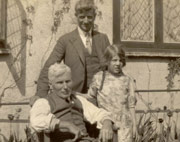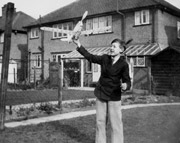I was now going to evening classes and the Art School was visited by Neville Kilvert Coates, who was the son of the Mayor of Watford at the time. N.K. Coates had just started an advertising art studio in Imperial Buildings, Ludgate Circus, London. I was offered a job at a good wage. I did very little artwork, but a lot of errands had to be run and tea to be made. I was now 15 years old.
I got to know my way around 'The City', which at this time still had horse drawn delivery wagons. It was very noisy because the wheels had steel rims, and all but the main roads were cobbled. New Bridge Street was made of tarred wooden blocks to reduce the noise, but after heavy rain they would swell and produce huge humps. There was always a strong smell of horse manure, and on hot summer days this dried and was blown like dust everywhere. The horses when they stopped were given more bags of food and when they shook their heads pieces of chaff were scattered into the air so that they sparkled in the sunlight.
I enjoyed working. The Fleet Street area was an exciting place. In the courts and side streets there was the roar of printing presses and the smell of hot metal and printing ink. Newspapers tied with string into bundles came clattering down roller chutes into delivery vans. On the 'Street' the newsvendors cried "Starnooz'nstandar!" which meant The Star, Evening News and The Standard. The first editions of the evening papers were on sale before midday.
N.K. Coates was an airbrush artist and a photograph retoucher, and in my spare time I was able to watch his techniques and to teach myself to use the airbrush. Another artist working there was Eric Courtney, who was also a musician who played with many of the top dance bands. The artist who impressed me most was Victor Deane, who did brilliant line illustrations, and who was not much older than me.
Now that I was working in London I had greater freedom. Sometimes I left work on Friday and spent the weekend at Aunt Lill and Uncle Fred Blackwell’s house "The House in the Wood" in Warlingham, Surrey. The only time I met members of the Cross family was on one of these visits.
 |
 |
| Fred Blackwell, Uncle Alf King and Joyce King in the garden at Warlingham, c1930. |
Me with my first model aircraft, c1937. |
My future with N.K. Coates looked quite limited, but one of his clients was Albert Joseph Beecher Stow. (He is no known relation to the author Harriet Beecher Stowe). Beecher Stow Studios was an advertising agency which was also in Imperial Buildings. Beecher Stow was losing his only employee, Albert Messino, and he told N.K. Coates that I would be a suitable replacement. For me it was an escape from all the menial tasks I was doing. Now instead of making the tea I would telephone an order and it would be delivered from the ABC Restaurant below our office. I was now able to do design and finished artwork, and to put into practice all I had learned about retouching photographs. I had to work hard to learn how to mark-up copy for typesetting, and how to order line blocks, half tone blocks, Stereos and Electros (both being methods of creating a letterpress printing plate) which newspapers had to get on time. I had to learn fast because Beecher Stow was going on holiday within a few weeks and he intended to leave me in control.
Albert Messino was a little older than me. He agreed to stay with Beecher Stow Studios for a week or two, so he was able to show me what I would be expected to do. He was interested in flying model aircraft and one lunchtime we took a bus to a shop in the Old Kent Road and both bought model kits. My box was a Vernon design and it contained a blueprint, spruce strips, balsa sheets, and cement. To cover the model there was thin silk, and for dope there was 'Banana Oil'. In addition there was a roughly carved propeller and some rubber-elastic to be wound up to power the propeller. When built the model was very heavy and unstable, so my first attempt was not at all successful.
Telephone numbers in those days were easier to remember. I have still not forgotten that the studio was CEN 7993 and that Samuel Jones was CEN 6500. (CEN stood for Central, an Exchange in the City of London, and was the three letters on the dial that became the numbers 236 when dialled.) We did not get a telephone at home in Watford until the late 1940s.
Beecher Stow Studios had one main client, Samuel Jones & Co Ltd whose trade included gummed and coated paper manufacturing. Their offices were only a few minutes walk away in Bridewell Place and their factory was in Camberwell. Their trademark was a Camberwell Beauty butterfly, and Butterfly Brand stationery was in all the shops then. (After WW2, Samuel Jones remained a client of Beecher Stow, but in later years parts of Samuel Jones were taken over by Wiggins Teap.) The Camberwell Beauty logo can still be seen in tiles over the entrance to a shopping centre in Camberwell, South London, near the site of the factory.
A.J. Beecher Stow was then about 40 years of age. He was a man of rather foreign appearance which was emphasized by his imperial beard. In the 1914-1918 war he had served in the Royal Artillery and he had been awarded the Military Medal and the Croix de Guerre. As a result of gunfire he was slightly deaf, or as he said "pals from Wapping" a reference to a time when he had misheard a request for "towels for washing".
 Home
Home